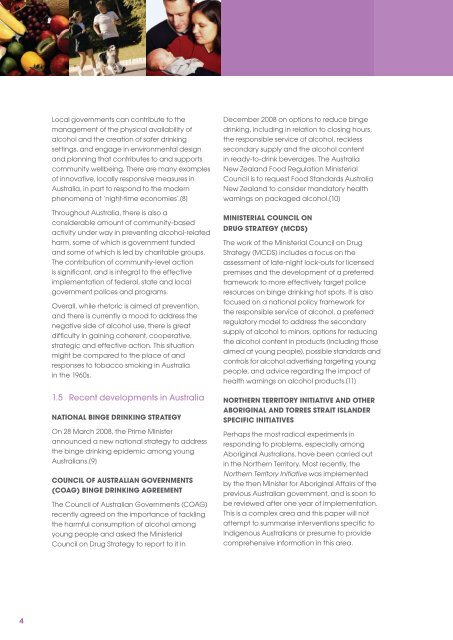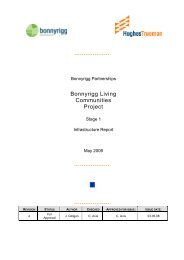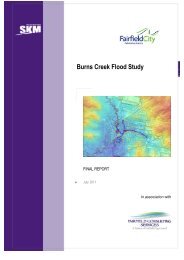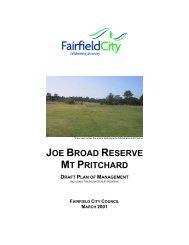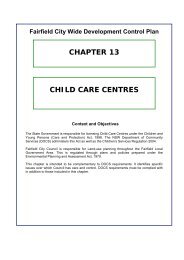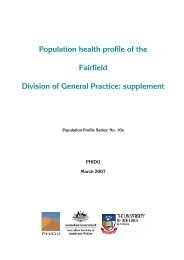Preventing Alcohol-related Harm in Australia - Department of Health
Preventing Alcohol-related Harm in Australia - Department of Health
Preventing Alcohol-related Harm in Australia - Department of Health
Create successful ePaper yourself
Turn your PDF publications into a flip-book with our unique Google optimized e-Paper software.
Local governments can contribute to themanagement <strong>of</strong> the physical availability <strong>of</strong>alcohol and the creation <strong>of</strong> safer dr<strong>in</strong>k<strong>in</strong>gsett<strong>in</strong>gs, and engage <strong>in</strong> environmental designand plann<strong>in</strong>g that contributes to and supportscommunity wellbe<strong>in</strong>g. There are many examples<strong>of</strong> <strong>in</strong>novative, locally responsive measures <strong>in</strong><strong>Australia</strong>, <strong>in</strong> part to respond to the modernphenomena <strong>of</strong> ‘night-time economies’.[8]Throughout <strong>Australia</strong>, there is also aconsiderable amount <strong>of</strong> community-basedactivity under way <strong>in</strong> prevent<strong>in</strong>g alcohol-<strong>related</strong>harm, some <strong>of</strong> which is government fundedand some <strong>of</strong> which is led by charitable groups.The contribution <strong>of</strong> community-level actionis significant, and is <strong>in</strong>tegral to the effectiveimplementation <strong>of</strong> federal, state and localgovernment polices and programs.Overall, while rhetoric is aimed at prevention,and there is currently a mood to address thenegative side <strong>of</strong> alcohol use, there is greatdifficulty <strong>in</strong> ga<strong>in</strong><strong>in</strong>g coherent, cooperative,strategic and effective action. This situationmight be compared to the place <strong>of</strong> andresponses to tobacco smok<strong>in</strong>g <strong>in</strong> <strong>Australia</strong><strong>in</strong> the 1960s.1.5 Recent developments <strong>in</strong> <strong>Australia</strong>National B<strong>in</strong>ge Dr<strong>in</strong>k<strong>in</strong>g StrategyOn 28 March 2008, the Prime M<strong>in</strong>isterannounced a new national strategy to addressthe b<strong>in</strong>ge dr<strong>in</strong>k<strong>in</strong>g epidemic among young<strong>Australia</strong>ns.[9]Council <strong>of</strong> <strong>Australia</strong>n Governments(COAG) B<strong>in</strong>ge Dr<strong>in</strong>k<strong>in</strong>g AgreementThe Council <strong>of</strong> <strong>Australia</strong>n Governments (COAG)recently agreed on the importance <strong>of</strong> tackl<strong>in</strong>gthe harmful consumption <strong>of</strong> alcohol amongyoung people and asked the M<strong>in</strong>isterialCouncil on Drug Strategy to report to it <strong>in</strong>December 2008 on options to reduce b<strong>in</strong>gedr<strong>in</strong>k<strong>in</strong>g, <strong>in</strong>clud<strong>in</strong>g <strong>in</strong> relation to clos<strong>in</strong>g hours,the responsible service <strong>of</strong> alcohol, recklesssecondary supply and the alcohol content<strong>in</strong> ready-to-dr<strong>in</strong>k beverages. The <strong>Australia</strong>New Zealand Food Regulation M<strong>in</strong>isterialCouncil is to request Food Standards <strong>Australia</strong>New Zealand to consider mandatory healthwarn<strong>in</strong>gs on packaged alcohol.[10]M<strong>in</strong>isterial Council onDrug Strategy (MCDS)The work <strong>of</strong> the M<strong>in</strong>isterial Council on DrugStrategy (MCDS) <strong>in</strong>cludes a focus on theassessment <strong>of</strong> late-night lock-outs for licensedpremises and the development <strong>of</strong> a preferredframework to more effectively target policeresources on b<strong>in</strong>ge dr<strong>in</strong>k<strong>in</strong>g hot spots. It is als<strong>of</strong>ocused on a national policy framework forthe responsible service <strong>of</strong> alcohol, a preferredregulatory model to address the secondarysupply <strong>of</strong> alcohol to m<strong>in</strong>ors, options for reduc<strong>in</strong>gthe alcohol content <strong>in</strong> products (<strong>in</strong>clud<strong>in</strong>g thoseaimed at young people), possible standards andcontrols for alcohol advertis<strong>in</strong>g target<strong>in</strong>g youngpeople, and advice regard<strong>in</strong>g the impact <strong>of</strong>health warn<strong>in</strong>gs on alcohol products.[11]Northern Territory <strong>in</strong>itiative and otherAborig<strong>in</strong>al and Torres Strait Islanderspecific <strong>in</strong>itiativesPerhaps the most radical experiments <strong>in</strong>respond<strong>in</strong>g to problems, especially amongAborig<strong>in</strong>al <strong>Australia</strong>ns, have been carried out<strong>in</strong> the Northern Territory. Most recently, theNorthern Territory Initiative was implementedby the then M<strong>in</strong>ister for Aborig<strong>in</strong>al Affairs <strong>of</strong> theprevious <strong>Australia</strong>n government, and is soon tobe reviewed after one year <strong>of</strong> implementation.This is a complex area and this paper will notattempt to summarise <strong>in</strong>terventions specific toIndigenous <strong>Australia</strong>ns or presume to providecomprehensive <strong>in</strong>formation <strong>in</strong> this area.4


